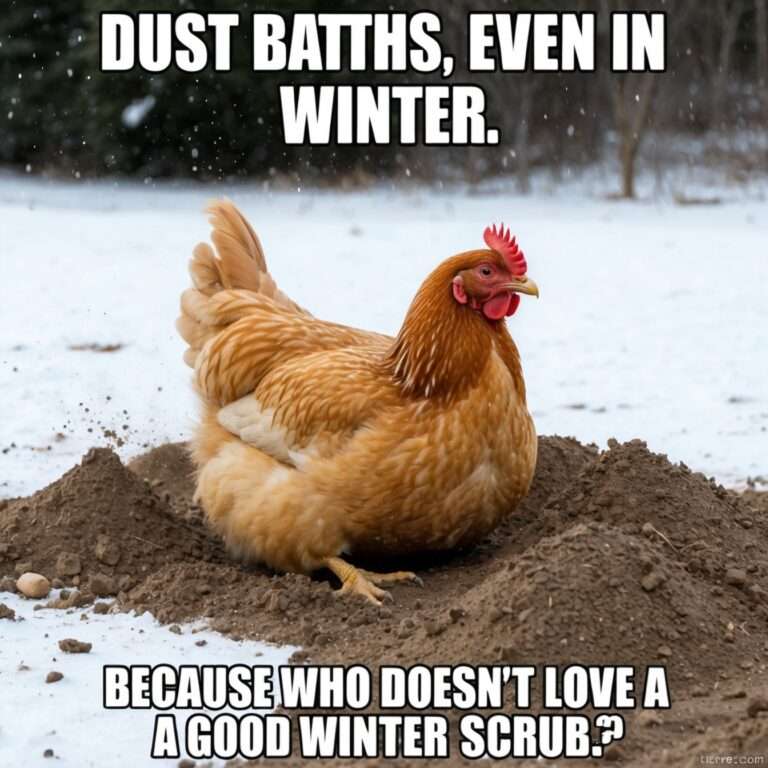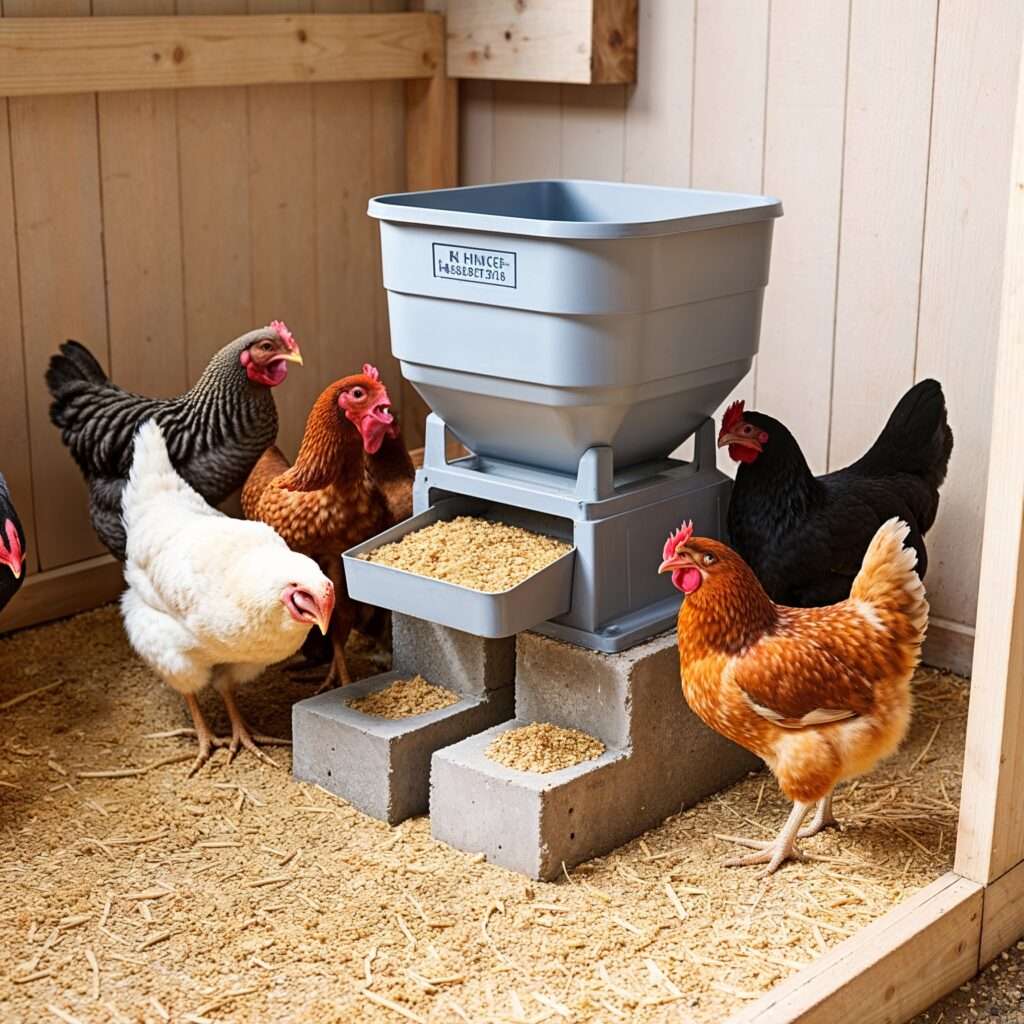
A simple and effective setup with a chicken feeder elevated on concrete blocks, ensuring clean and accessible feeding.
Optimal Chicken Feeder Placement: Tips for Healthier and Cleaner Flocks
Proper placement and elevation of your chicken feeder are essential for maintaining flock health, minimizing feed waste, and keeping pests at bay. Elevating feeders further optimizes feeding by promoting cleanliness and organization in the coop. This guide will provide actionable tips for optimal chicken feeder placement, the benefits of elevating feeders, and practical methods for creating an elevated setup that works for your chickens and coop design.
1. Best Placement for a Chicken Feeder
The right feeder placement can reduce stress, prevent feed contamination, and encourage natural feeding behavior. Here are key considerations for placing your feeder:
Place Feeders in Low-Traffic Areas
- Why: Chickens prefer calm, quiet spaces for eating. High-traffic areas can cause stress and discourage consistent feeding.
- Where: Position feeders along the coop’s edge or in a quiet corner, away from perching or sleeping areas to avoid contamination.
- Avoid: Placing feeders near water sources to prevent feed from getting wet and spoiled.
Protect Feeders from Sunlight and Rain
- Why: Exposure to sunlight can spoil feed, while rain can lead to mold growth and wasted feed.
- Tips: If placing feeders near windows or openings, ensure they are covered with a roof or positioned in a sheltered area.
Ensure Easy Access for All Chickens
- Guidelines:
- Provide at least one feeding port per 4-5 chickens to reduce pecking order conflicts.
- Maintain enough space around the feeder to allow chickens to eat comfortably without overcrowding.
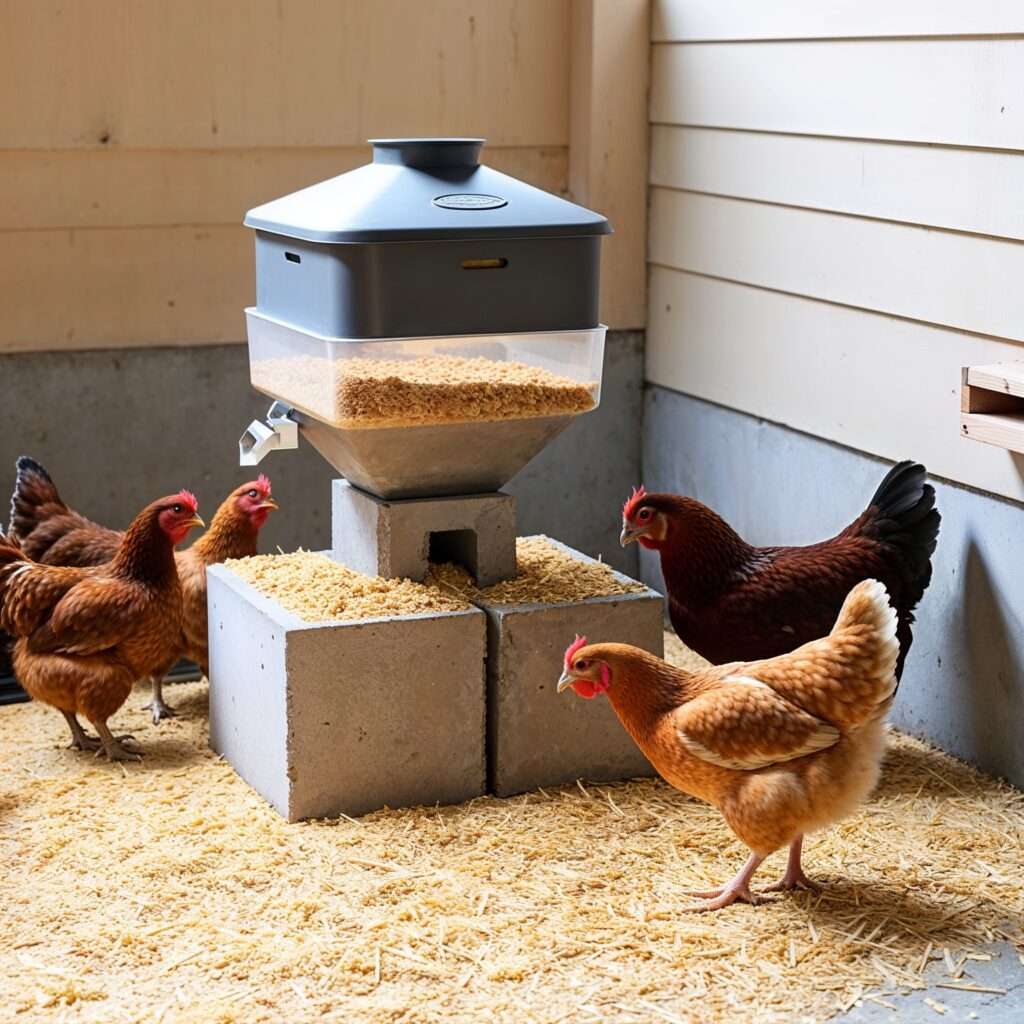
2. Why Elevate Your Chicken Feeder | Optimal Chicken Feeder Placement
Elevating your chicken feeder can significantly improve flock health, reduce waste, and simplify coop maintenance. Here are the primary reasons to elevate:
1. Prevents Feed Contamination
- How: Elevating feeders keeps them above ground level, reducing exposure to droppings, dirt, and bedding.
- Benefit: Cleaner feed means healthier chickens and less risk of disease transmission.
2. Reduces Feed Waste
- Why: Chickens tend to scratch or kick bedding into ground-level feeders. An elevated setup minimizes this behavior, keeping feed clean and reducing wastage.
3. Discourages Pests and Rodents
- How: Rodents find it harder to access elevated feeders, helping to maintain a pest-free environment.
- Tip: Combine elevation with proper coop sanitation for optimal results.
4. Promotes Better Posture for Chickens
- Why: Feeding from a feeder elevated to the height of a chicken’s back prevents unnecessary neck strain.
- Tip: Adjust the feeder height to match the smallest adult chicken in your flock for comfort and accessibility.
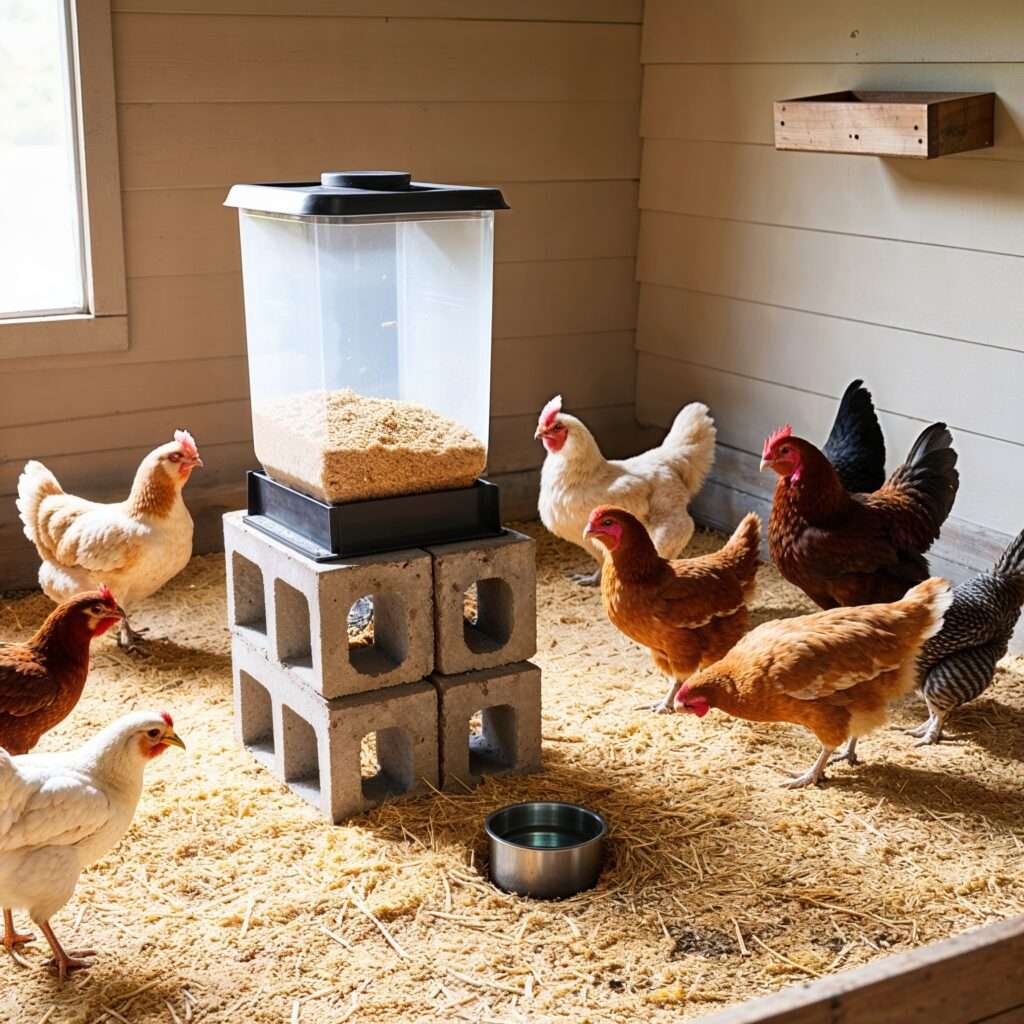
3. Easy Ways to Elevate Your Feeder | Optimal Chicken Feeder Placement
There are various simple and effective ways to elevate your chicken feeder. Choose a method that fits your coop layout and flock needs:
1. Cinderblocks (Stable and Cost-Effective)
- How to Use: Place the feeder on top of two to four cinderblocks.
- Pros:
- Affordable and widely available.
- Easy to adjust height by adding or removing blocks.
- Tip: Clean blocks regularly to prevent buildup of dirt or pests.
2. Hanging Feeder (Space-Saving Option)
- How to Use: Suspend the feeder from a beam or ceiling using a rope or chain. Adjust height as needed.
- Pros:
- Keeps feed out of reach of rodents.
- Ideal for small coops with limited floor space.
- Cons: Requires sturdy support to prevent swinging.
3. Wooden Platform or Stand
- How to Use: Build a custom wooden stand to lift the feeder off the ground.
- Pros:
- Customizable to fit your coop design.
- Provides a stable, elevated surface for feeding.
- Cons: Requires basic carpentry skills.
4. PVC Pipe Frame (Lightweight and Portable)
- How to Use: Assemble a lightweight PVC stand to hold the feeder.
- Pros:
- Resistant to moisture and easy to move.
- Ideal for temporary or seasonal adjustments.
- Cons: May not support very heavy feeders.
5. Bricks or Concrete Pavers
- How to Use: Arrange bricks or pavers to raise the feeder slightly above ground level.
- Pros:
- Affordable and readily available.
- Provides a sturdy base.
- Cons: Limited height flexibility.
6. Adjustable Feeder Legs
- How to Use: Many feeders come with adjustable legs that allow you to modify the height as your chickens grow.
- Pros:
- Convenient and easy to use.
- Ideal for flocks with varying chicken sizes.
7. Buckets or Plastic Containers (Temporary Setup)
- How to Use: Place the feeder on top of an overturned bucket or bin.
- Pros:
- Cheap and easy to implement.
- Great for testing different heights.
- Cons: Less stable than permanent setups.
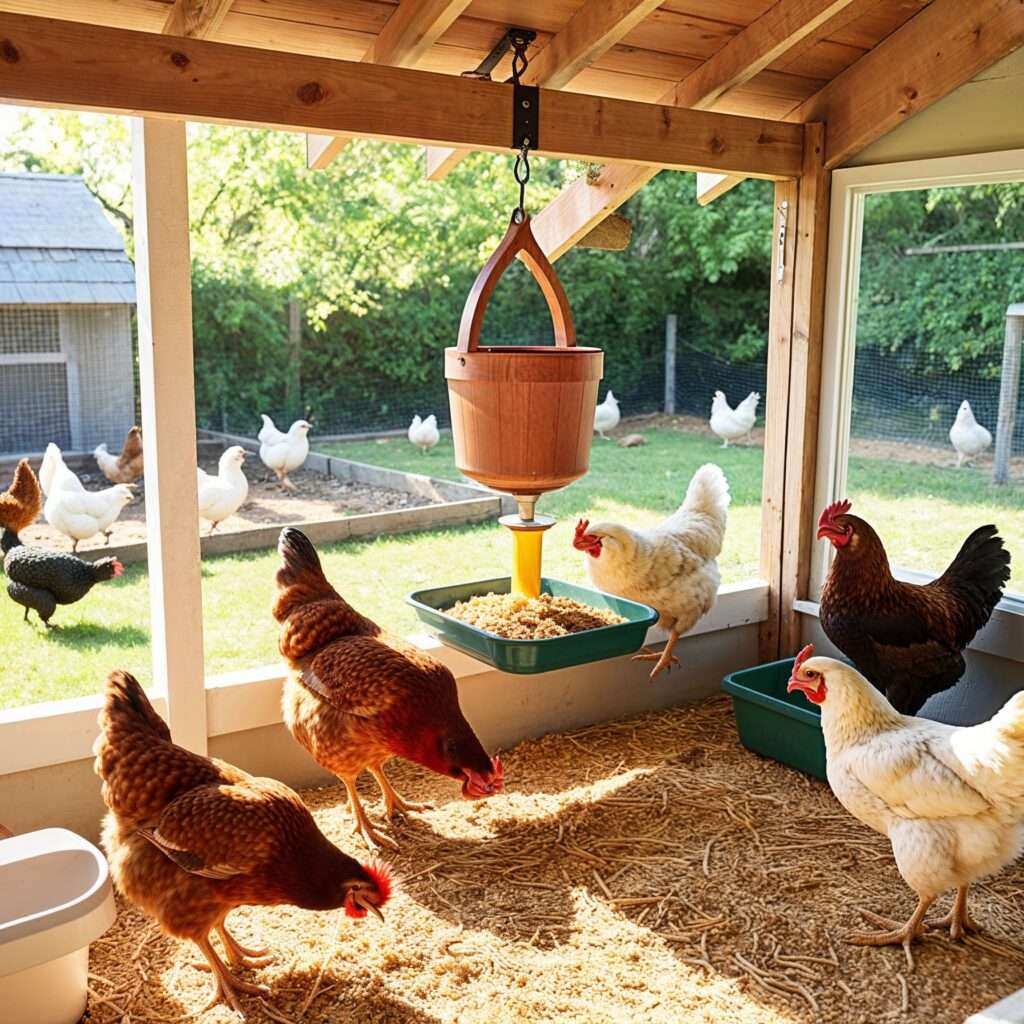
4. Tips for Maintaining an Elevated Feeder
An elevated feeder requires proper maintenance to ensure long-term benefits:
- Clean Regularly: Even with elevation, feeders can accumulate debris. Clean them weekly to prevent contamination.
- Check for Stability: Make sure your feeder is level and secure to avoid tipping or spillage.
- Monitor Feed Levels: Use a clear or labeled feeder to track feed levels and avoid running out unexpectedly.
- Adjust as Needed: As your flock grows or changes, adjust feeder height to match the smallest adult chicken’s back height.
Conclusion
Optimal chicken feeder placement is crucial for creating a healthier and more efficient coop environment. By placing the feeder in a calm, sheltered spot and elevating it above the ground, you can reduce waste, deter pests, and promote better feeding habits among your flock.
Elevating a feeder is easy to achieve using cinderblocks, hanging systems, or custom stands. Regular maintenance, such as cleaning and stability checks, ensures the feeder remains effective over time.
Implementing these best practices will not only enhance your chickens’ health and well-being but also streamline your coop management routine. Start optimizing your chicken feeder placement today to build a cleaner, more productive backyard environment for your flock.
SOURCES
Proper placement and elevation of chicken feeders are crucial for maintaining flock health, minimizing feed waste, and preventing pest issues. The following resources provide valuable insights and best practices for optimizing feeder setup:
- Optimising Your Chicken Coop Food and Water Set Up
This article discusses the importance of strategic placement for feeders and waterers within the chicken coop. It emphasizes that elevating these items can minimize spillage and contamination, suggesting methods such as placing feeders on bricks or hanging them from the roof. - Raising the Debate: Should Chicken Feeders Be Elevated Off the Ground?
This resource explores the benefits of elevating chicken feeders, including enhanced cleanliness, health, and efficiency in the coop. It recommends elevating feeders approximately 4-6 inches off the ground to encourage comfortable feeding and reduce feed wastage. - Where to Put Chicken Feeder?
This guide provides insights into the optimal placement of chicken feeders, considering factors such as indoor versus outdoor positioning, protection from weather elements, and accessibility for the flock. It also discusses the importance of feeder capacity and preventing access by wild animals. - Feeder Height
This forum thread offers practical advice on adjusting feeder height as chickens grow, suggesting that feeders be placed at a height where chickens have to reach up slightly to access the feed, which helps reduce spillage and contamination.
These resources provide comprehensive guidance on the effective placement and elevation of chicken feeders, contributing to a healthier and more efficient poultry management system.
Sources
Paranoid Prophet – What Not to Feed Chickens: Common Mistakes and Hidden Dangers
This resource lists foods that can harm chickens, including toxic plants, processed foods, and common household scraps. It provides actionable advice for avoiding these dangers and maintaining a safe and balanced diet for your flock.
Paranoid Prophet – Poultry Care & Backyard Flocks Category
This category page provides a collection of resources, tips, and guides dedicated to raising healthy backyard chickens. Topics include feeding practices, coop management, and seasonal care strategies for poultry.
Paranoid Prophet – Wheatgrass and Hay for Winter Chickens
This article explores the benefits of wheatgrass and hay as supplemental forage for chickens during the winter months. It explains how these additions can improve chicken health and diversify their diet during colder seasons.
Paranoid Prophet – Top Cover Crops for Southeastern U.S. Gardens
A guide to selecting the best cover crops for improving soil health and supporting chicken grazing in the Southeastern U.S. It highlights options like crimson clover, rye, and winter peas, emphasizing their dual benefits for soil and poultry.
FAQ: Poultry Care & Backyard Flocks
Feeding Chickens
1. What are the benefits of feeding wheatgrass and hay to chickens in winter?
Wheatgrass and hay provide essential nutrients and forage opportunities during winter when fresh greens are scarce. Wheatgrass is rich in vitamins A and E, while hay offers fiber and enrichment for chickens to peck and scratch.
2. What foods should I avoid feeding my chickens?
Avoid feeding chickens raw potato peels, chocolate, avocado, caffeine, salty snacks, and moldy food. These can cause toxicity or health issues. Always check whether scraps are safe before feeding them to your flock.
3. Can chickens eat cover crops?
Yes, chickens can forage on many cover crops like clover, rye, and Austrian winter peas. These crops provide nutritious greens, but overgrazing should be avoided to maintain healthy crop growth.
Coop and Feeder Management
4. How do I set up the best chicken feeder placement?
Place feeders in low-traffic areas of the coop, away from water sources, to prevent contamination. Elevate the feeder to keep feed clean and discourage pests, setting it at the back height of the smallest adult chicken for comfort.
5. Should I elevate chicken feeders?
Yes, elevating feeders reduces feed waste, prevents contamination from droppings, and makes it harder for rodents to access the feed. Hanging feeders or using platforms are common methods for elevation.
6. How often should I clean the chicken feeder?
Clean feeders weekly to remove any leftover feed, dust, or debris. This prevents mold growth and keeps your flock healthy.
Seasonal Chicken Care
7. What are the best winter cover crops for chickens in the Southeastern U.S.?
Top winter cover crops include winter rye, crimson clover, Austrian winter peas, and daikon radish. These crops improve soil health and provide fresh forage for chickens.
8. How can I keep chickens entertained in winter?
Provide enrichment like hanging cabbages, scatter feed in hay, or offer forage crops like wheatgrass. Keeping them active prevents boredom and promotes healthy behaviors.
9. Should I change chicken feed during winter?
Yes, consider higher-protein feed or supplements during winter when chickens expend more energy staying warm. Providing scratch grains as a treat can also help maintain body heat.
Health and Safety
10. What are the dangers of feeding chickens moldy food?
Moldy food can contain mycotoxins that cause illness or even death in chickens. Always discard moldy or spoiled feed to ensure the health of your flock.
11. Can chickens eat kitchen scraps?
Yes, chickens can eat many kitchen scraps, including vegetables, fruits, and grains. However, avoid toxic items like onions, garlic, and processed foods high in salt or sugar.
12. How do I prevent pests in my chicken coop?
Keep feed elevated, store it in airtight containers, and regularly clean the coop to prevent rodents and insects from taking up residence.
Soil and Forage Management
13. How do cover crops benefit chickens?
Cover crops like rye and clover improve soil health while providing fresh greens for chickens to forage. These crops enrich their diet naturally and reduce the need for store-bought supplements.
14. Can cover crops improve my garden soil while raising chickens?
Yes, planting cover crops fixes nitrogen in the soil, improves aeration, and prevents erosion. Chickens grazing on these crops can fertilize the soil naturally with their droppings.
15. How do I manage crop rotation with chickens?
Divide the area into zones and rotate chickens to prevent overgrazing. Allow crops to regrow in one section while another is being grazed. This approach maintains healthy forage and soil.
